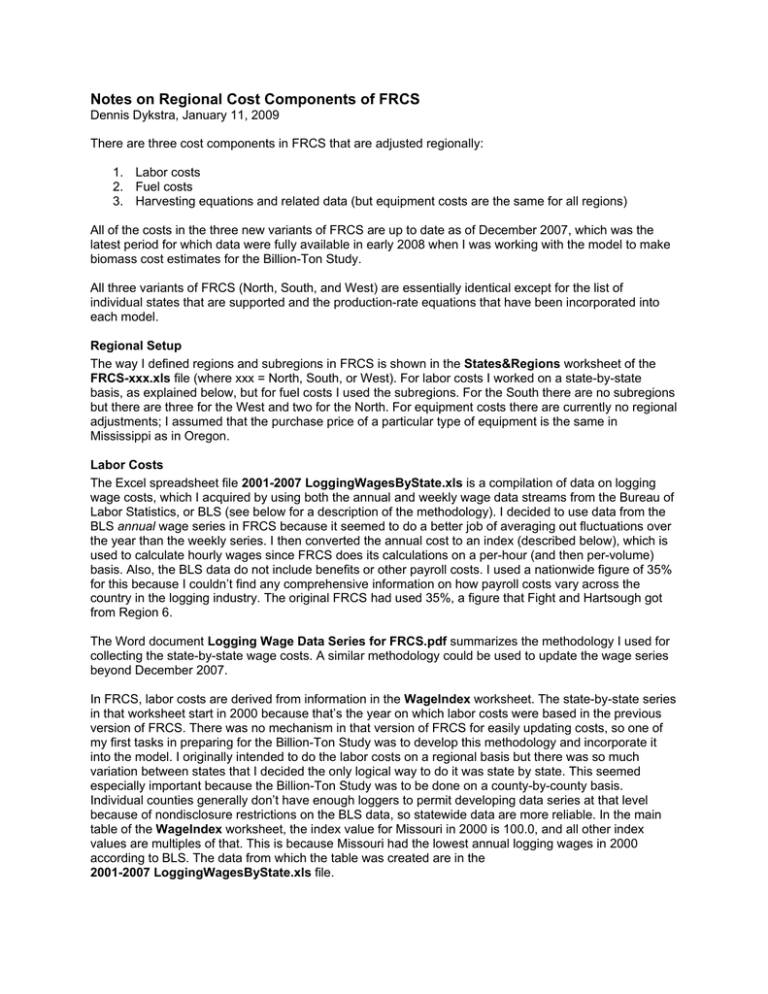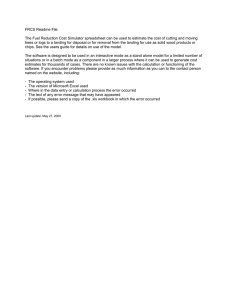Notes on Regional Cost Components of FRCS
advertisement

Notes on Regional Cost Components of FRCS Dennis Dykstra, January 11, 2009 There are three cost components in FRCS that are adjusted regionally: 1. Labor costs 2. Fuel costs 3. Harvesting equations and related data (but equipment costs are the same for all regions) All of the costs in the three new variants of FRCS are up to date as of December 2007, which was the latest period for which data were fully available in early 2008 when I was working with the model to make biomass cost estimates for the Billion-Ton Study. All three variants of FRCS (North, South, and West) are essentially identical except for the list of individual states that are supported and the production-rate equations that have been incorporated into each model. Regional Setup The way I defined regions and subregions in FRCS is shown in the States&Regions worksheet of the FRCS-xxx.xls file (where xxx = North, South, or West). For labor costs I worked on a state-by-state basis, as explained below, but for fuel costs I used the subregions. For the South there are no subregions but there are three for the West and two for the North. For equipment costs there are currently no regional adjustments; I assumed that the purchase price of a particular type of equipment is the same in Mississippi as in Oregon. Labor Costs The Excel spreadsheet file 2001-2007 LoggingWagesByState.xls is a compilation of data on logging wage costs, which I acquired by using both the annual and weekly wage data streams from the Bureau of Labor Statistics, or BLS (see below for a description of the methodology). I decided to use data from the BLS annual wage series in FRCS because it seemed to do a better job of averaging out fluctuations over the year than the weekly series. I then converted the annual cost to an index (described below), which is used to calculate hourly wages since FRCS does its calculations on a per-hour (and then per-volume) basis. Also, the BLS data do not include benefits or other payroll costs. I used a nationwide figure of 35% for this because I couldn’t find any comprehensive information on how payroll costs vary across the country in the logging industry. The original FRCS had used 35%, a figure that Fight and Hartsough got from Region 6. The Word document Logging Wage Data Series for FRCS.pdf summarizes the methodology I used for collecting the state-by-state wage costs. A similar methodology could be used to update the wage series beyond December 2007. In FRCS, labor costs are derived from information in the WageIndex worksheet. The state-by-state series in that worksheet start in 2000 because that’s the year on which labor costs were based in the previous version of FRCS. There was no mechanism in that version of FRCS for easily updating costs, so one of my first tasks in preparing for the Billion-Ton Study was to develop this methodology and incorporate it into the model. I originally intended to do the labor costs on a regional basis but there was so much variation between states that I decided the only logical way to do it was state by state. This seemed especially important because the Billion-Ton Study was to be done on a county-by-county basis. Individual counties generally don’t have enough loggers to permit developing data series at that level because of nondisclosure restrictions on the BLS data, so statewide data are more reliable. In the main table of the WageIndex worksheet, the index value for Missouri in 2000 is 100.0, and all other index values are multiples of that. This is because Missouri had the lowest annual logging wages in 2000 according to BLS. The data from which the table was created are in the 2001-2007 LoggingWagesByState.xls file. If you go to the Interface_page worksheet of FRCS and change the name of the currently selected state in the dropdown list, then go back to the WageIndex worksheet, you’ll see the estimated 2007 labor costs for that state in the range N12:O15. If the state is not in the region corresponding to the FRCS variant you are region, there won’t be any cost information shown. The labor cost estimates for the selected state are replicated in B17:C17 of the CostUpdates worksheet and from there are used in calculating estimated logging costs. In the range B5:G9 of the CostUpdates worksheet there is a shaded area in which I originally attempted to update labor costs using regional averages. This involved using several states in each region as proxies for the whole region. I eventually decided to abandon this approach and use the complete stateby-state method instead. I left the data there just for documentary purposes. One other thing about labor costs—FRCS separates the cost of felling and bucking from that of other logging positions, assuming that fallers get paid a higher wage than other workers. This is true in the Pacific Northwest but might not be true elsewhere. However, I assumed that it was true everywhere and used the same percentage differential between those two cost categories as was used in the 2000 cost data for the original version of FRCS. For harvesting of short-rotation woody crops the “All Others” labor cost category should probably be used. Fuel Costs The data series for diesel prices comes from a website maintained by the Energy Information Administration (http://tonto.eia.doe.gov/oog/info/wohdp/diesel.asp). I segregated these costs by subregion because they vary a lot over the US but it didn’t seem that there was enough variability to justify doing it on a state-by-state basis. The fuel costs I used are shown in B10:G10 of the CostUpdates worksheet in the FRCS-xxx.xls file. The main thing that can be said about fuel costs is that they are highly variable. Equipment Costs These don’t vary regionally in FRCS because I couldn’t locate reliable cost data for all regions and didn’t have any funding to buy data from sources like the Green Guide. In fact, really the South is the only region for which good data series are available on logging equipment costs. For FRCS I used a rather simplistic approach. Starting with the year 2002 data from the original FRCS, I used the Producer Price Index for Construction Equipment Manufacturing from the BLS (series pcu333120333120, Feb 2008, http://www.bls.gov/data/) to update the cost indices. The 2002 national index was 176.6 and the 2007 national index was 208, so the multiplier to calculate estimated 2007 costs from the original 2002 estimates is 208/176.6 = 1.18. You can see this in B4:G4 of the CostUpdates worksheet in FRCS-xxx.xls. The resulting estimated purchase prices are in B21:T21. These are subsequently used in the MachineCosts worksheet to calculate hourly equipment operating costs. Production Rates A major thing that distinguishes the three variants of FRCS (North, South, West) are the production-rate equations. I spent a lot of time adding new equations for the South and North, and making sure that they were implemented in a consistent way throughout. Eventually I hope to put together a comprehensive version of FRCS that includes production-rate equations for all three regions and that would switch automatically to the appropriate equations for any particular state. So far I haven’t had time to do that so the variants remain separate.
